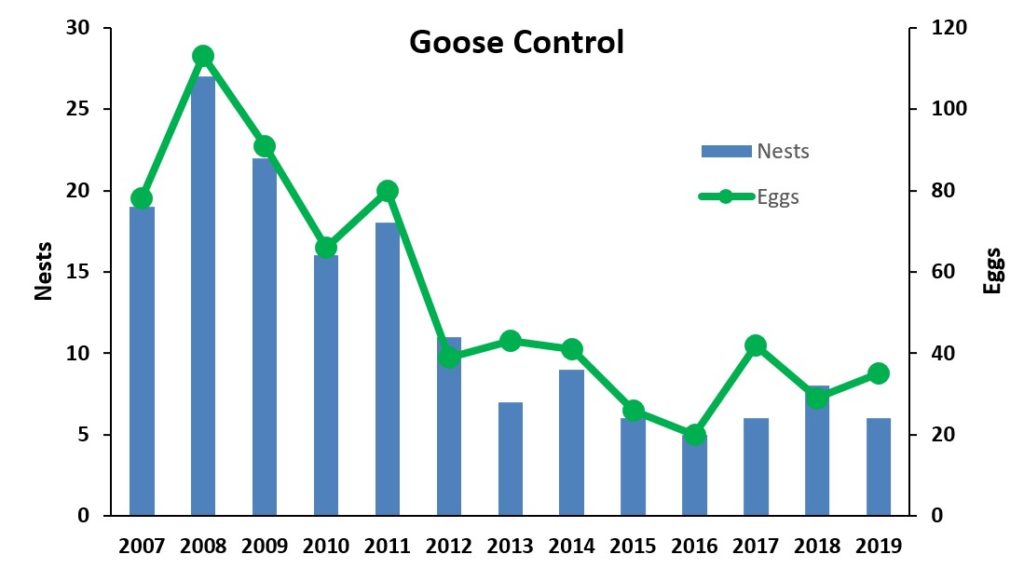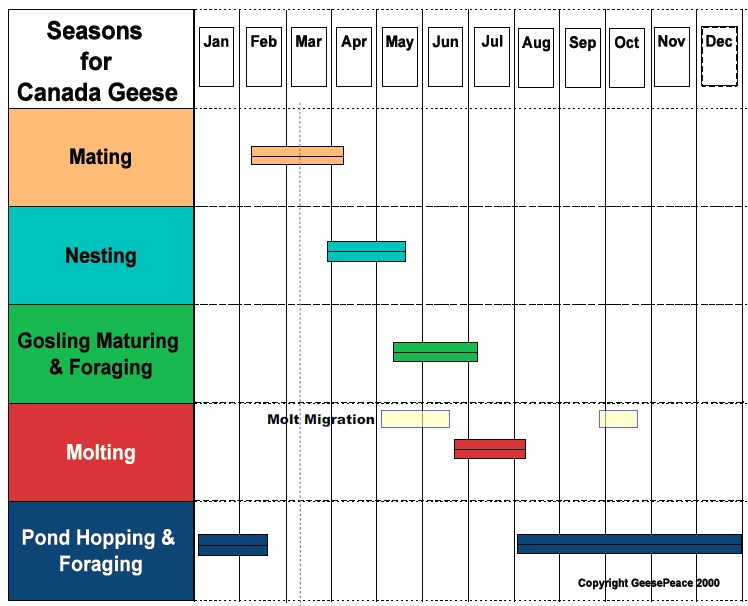 Canadian Geese in flight can be majestic, grand, and inspiring. It’s when they get down on land that another problem appears… goose poop. And it’s not just unsightly. Some studies show that waterfowl can produce 25% to 34% of the total phosphorous budget in a watershed. And phosphorous is what enables the growth of weeds and algae. Goose poop is also unhealthy.
Canadian Geese in flight can be majestic, grand, and inspiring. It’s when they get down on land that another problem appears… goose poop. And it’s not just unsightly. Some studies show that waterfowl can produce 25% to 34% of the total phosphorous budget in a watershed. And phosphorous is what enables the growth of weeds and algae. Goose poop is also unhealthy.
In the fall 2006 Three Lakes survey, 88% of the respondents said geese droppings were “some” or “serious” problems, one of the top three problems identified in the watershed. And community members were overwhelmingly in favor of oiling eggs and following the approved protocol to help manage the impact of geese.
Goose facts
Migratory Canadian geese are not the same as resident geese. Migratory geese nest in Canada. If a goose is nesting here, it’s a resident goose, and it will not migrate. Resident geese generally fly no more than 100 – 200 miles to find food and safety. Resident geese were introduced here after hunting reduced the range of Canadian geese, but their population grew rapidly and complaints about their numbers (and their droppings) were heard in this area starting around 1985.
Geese live about 20 years, start to nest after about 3 years, and lay on average 5 eggs each year. Geese have a very strong tendency to return to where they were born to nest. Left unchecked, their population will double every 5 years. While feeding, geese defecate every 7 minutes. Each goose produces 1 to 3 pounds of waste per day. In addition to phosphorous, they contribute pathogens such as e-coli and the bacteria that cause swimmer’s itch, as well as giardia, cryptosporidium, and campylobacter. Geese are one vector for the spread of invasive plants such as milfoil and water chestnut.
And even a few can make a difference. From a report on moving just four geese out of a swimming area: “We at Devils Lake, Lincoln County, Oregon relocated all four domestic geese that had taken up residence at one beach access, and had immediate reductions in the bacterial levels from 1500/100ml to 18/100ml.“
Three Lake Council Activities
When the survey results told us how big and widespread the problem of geese droppings were, we decided that the Three Lakes Council should take some steps. We attended classes. We spoke to people in Federal, State, and local government organizations, people at other lakes, and the Humane Society, GeesePeace, and PETA. And then we took action. It turns out that a little bravery and a lot of corn oil can make a difference.
In 2007, we thought we were off to a great start by oiling 68 eggs in 18 nests. We learned a lot – like to ignore the noise – and that the geese would get right back on the nests after we were done. We were probably more upset than the geese! And in 2007, when the geese didn’t have goslings to tie them here, many of them took off for greener pastures while they molted.
But that was just the start. In 2008, thanks to the help of a lot of “goose spotters”, we found 30 nests, and oiled 113 eggs in 27 nests. For the first time, we found an active nest on Lake Rippowam as well as nests on Oscaleta and Waccabuc. The island on Waccabuc in 2008 had 17 nests and 67 eggs – nearly the number found all over the lakes in 2007.
Thanks to the dedicated members of the “geese team”, we’ve continued oiling eggs every spring since 2007. We seem to be having an effect, as the number of nests is decreasing. Some of this could be because of predation or weather. Some years, paired geese never seem to settle in to incubation. We are grateful to those who climb into boats in cold spring weather and face the geese in order to make this happen. Let us know if you spot nesting geese! In April, if you see a solitary goose, the mate is likely on a nest nearby.
Best practices
Some things that everyone can do to make our shores less attractive to geese.
- Don’t feed the geese. Many of the geese in our lakes will approach people, a clear indication that they are used to getting fed. Don’t do it. It’s not healthy for the geese and it’s not healthy for our lakes.
- Plant a border. Geese are one of the few wild animals that find the typical lake landscaping just perfect! If asked, they would request a grassy lawn visible from lake waters. If they can’t see out to the lake because of a tall edging of bushes or grasses next to the lawn, the grass won’t be as inviting to feed on.
- Interfere and bother. A two-foot fence made of 5 strands of monofilament line can deter geese from docks, floats, and lawns while they are molting and can’t fly. People have had success using remote controlled cars and boats to encourage them to leave the area. Also a laser pointer has had some success at dusk or dawn – the spots on the ground or water appear to annoy geese enough to make them get up and move. If you are in your boat and see geese on the lake, go towards them to make them feel less comfortable and move. It’s legal to herd or harass geese, but not to hurt them.
When cleaning up after geese, don’t throw poop into the water. Scoop up their waste and put it into the trash to get it out of the watershed.
Geese calendar
Geese generally nest between April and mid-May. If they have goslings that can’t fly, geese won’t leave the area. If they are too young to nest or don’t have goslings, geese can be encouraged to leave between mid-May and mid-June, when they start to molt. This is the major benefit of reducing nesting success, because geese can then fly to more attractive locations. Once the geese molt, they can’t fly, and there is no getting them off the lakes – but this is also a time when fencing or high grasses might help keep them off our lawns. By mid-August, geese can fly again and we’ll get local, visiting, and migrating populations, but they can be discouraged and chased away.

